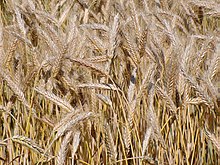
Back شيقم Arabic شيقم ARZ Kvėitrogē BAT-SMG Трыцікале Byelorussian Трыцікале BE-X-OLD Тритикале Bulgarian Triticale Catalan Tritikále Czech Тритикале CV Triticale Danish
| Triticale | |
|---|---|

| |
| Scientific classification | |
| Kingdom: | Plantae |
| Clade: | Tracheophytes |
| Clade: | Angiosperms |
| Clade: | Monocots |
| Clade: | Commelinids |
| Order: | Poales |
| Family: | Poaceae |
| Subfamily: | Pooideae |
| Supertribe: | Triticodae |
| Tribe: | Triticeae |
| Genus: | × Triticosecale Wittm. ex A. Camus. |
| Species | |
|
See text | |
| Synonyms | |
|
× Triticale Tscherm.-Seys. ex Müntzing | |
Triticale (/trɪtɪˈkeɪliː/; × Triticosecale) is a hybrid of wheat (Triticum) and rye (Secale) first bred in laboratories during the late 19th century in Scotland and Germany.[1] Commercially available triticale is almost always a second-generation hybrid, i.e., a cross between two kinds of primary (first-cross) triticales. As a rule, triticale combines the yield potential and grain quality of wheat with the disease and environmental tolerance (including soil conditions) of rye. Only recently [when?] has it been developed into a commercially viable crop. Depending on the cultivar, triticale can more or less resemble either of its parents. It is grown mostly for forage or fodder, although some triticale-based foods can be purchased at health food stores and can be found in some breakfast cereals.
When crossing wheat and rye, wheat is used as the female parent and rye as the male parent (pollen donor). The resulting hybrid is sterile and must be treated with colchicine to induce polyploidy and thus the ability to reproduce itself.
The primary producers of triticale are Poland, Germany, Belarus, France and Russia. In 2014, according to the Food and Agriculture Organization (FAO), 17.1 million tons were harvested in 37 countries across the world.[2]
The triticale hybrids are all amphidiploid, which means the plant is diploid for two genomes derived from different species. In other words, triticale is an allotetraploid. In earlier years, most work was done on octoploid triticale. Different ploidy levels have been created and evaluated over time. The tetraploids showed little promise, but hexaploid triticale was successful enough to find commercial application.[3]
The CIMMYT (International Maize and Wheat Improvement Center) triticale improvement program was intended to improve food production and nutrition in developing countries. Triticale was thought to have potential in the production of bread and other food products, such as cookies, pasta, pizza dough and breakfast cereals.[3] The protein content is higher than that of wheat, although the glutenin fraction is less. The grain has also been stated to have higher levels of lysine than wheat.[4] Acceptance would require the milling industry to adapt to triticale, as the milling techniques employed for wheat are unsuited to triticale.[5] Past research indicated that triticale could be used as a feed grain and, particularly, later research found that its starch is readily digested.[6] As a feed grain, triticale is already well established and of high economic importance. It has received attention as a potential energy crop, and research is currently being conducted on the use of the crop's biomass in bioethanol production. Triticale has also been used to produce vodka.[7][8]
- ^ Stace, C. A. (1987), "Triticale: A Case of Nomenclatural Mistreatment", Taxon, 36 (2): 445–452, doi:10.2307/1221447, JSTOR 1221447
- ^ "Food and Agricultural commodities production". FAO Statistics Division. Archived from the original on 2012-04-07. Retrieved 2016-04-05.
- ^ a b Mergoum, Mohamed; Gómez-Macpherson, Helena (2004). "Triticale improvement and production" (PDF). FAO. Retrieved 2010-11-25.[permanent dead link]
- ^ Larter, E. N. "Triticale". Agriculture. The Canadian Encyclopedia. Archived from the original on 2017-09-02. Retrieved 2009-06-19.
- ^ Sell, J.L.; Hodgson, G.C.; Shebeski, L.H. (1962) Triticale as a potential component of chick rations Archived 2013-01-15 at archive.today Canadian Journal of Animal Science, Volume 42, Number 2
- ^ Bird, S. H; Rowe, J. B.; Choct, M.; Stachiw, S.; Tyler, P.; Thompson, R. D. (1999) In vitro fermentation of grain and enzymatic digestion of cereal starch Recent Advances in Animal Nutrition, Vol 12, pp. 53–61
- ^ France, Marie (6 May 2019). "This distillery produces gin and vodka from locally grown bio-dynamic triticale". www.spiritshunters.com/. Retrieved 31 January 2023.
- ^ Sharman, Linda (April 2019). "WA distillery in High Spirits". Farm Weekly Australia. Retrieved 31 January 2023.
© MMXXIII Rich X Search. We shall prevail. All rights reserved. Rich X Search